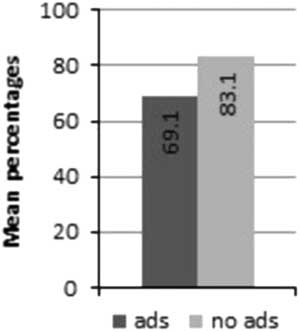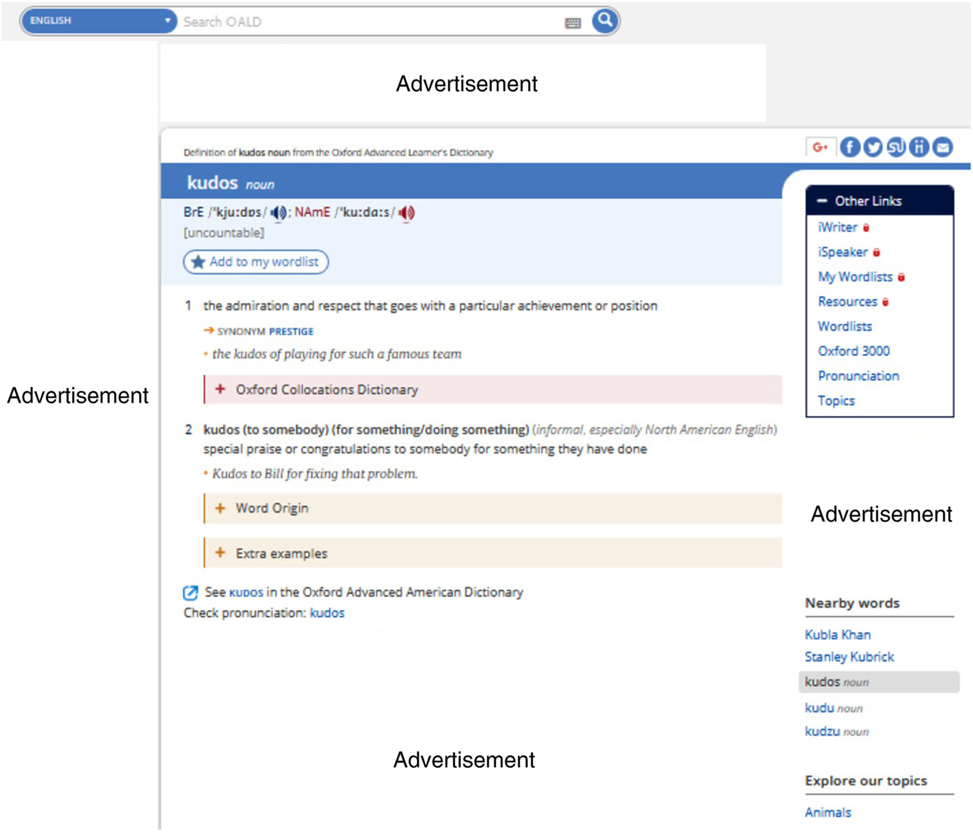1 Introduction
The late 20th century witnessed a serious drop in sales figures of dictionaries and encyclopedias. In the age of globalization, people still need high-quality dictionaries, but they want them to be available online free of charge. This has serious consequences for dictionary publishers. On the one hand, publishing houses largely automate dictionary compilation to reduce production costs (cf. Rundell, Reference Rundell2012). On the other hand, however, they need to fall back on advertisements to cover the costs of producing, maintaining, and marketing dictionary content available on the Internet (Béjoint, Reference Béjoint2015: 23). The major advanced learners’ dictionaries are already available online for free, and it is expected that “this business model (financed by advertisements) is likely to keep flourishing” (Heuberger, Reference Heuberger2015: 42). Yet, although advertisements on a dictionary website can generate substantial revenue, a noisy site may alienate its users (Nesi, Reference Nesi2015: 587; Rundell, Reference Rundell2011). What is more, it is feared that advertisements may affect learning. Dziemianko (Reference Dziemianko2011), for example, suspects that learning from reference to an advertisement-free dictionary might be easier. In her studies (Dziemianko, Reference Dziemianko2010, Reference Dziemianko2011), learners who consulted the online Collins COBUILD Advanced English Dictionary (COBUILD6), which was available via a pin code to the owners of the print version and included no advertisements, retained significantly more information than those who used the free online version of the Longman Dictionary of Contemporary English (LDOCE5), which featured much noise. It should be remembered, though, that those investigations were not designed to test the effect of advertisements in dictionaries on language learning, and the abovementioned conjecture was a possible, though not empirically verified, explanation of the differences observed in retention. As such, it is not so much a conclusion as a speculative hypothesis that needs to be systematically tested. Unfortunately, no dictionary user research published to date has been devoted to the significance of advertisements in online dictionaries.
The aim of the paper is to investigate the role of advertisements in dictionary-based language reception, production, and learning. It also attempts to establish whether advertisements on a dictionary website influence the time of dictionary-based task performance. Three research questions are addressed:
1. Do advertisements in online dictionaries affect language comprehension and use?
2. Does the time of performing receptive and productive tasks on the basis of online dictionary consultation depend on whether the dictionary website includes advertisements?
3. Is the retention of meaning after online dictionary consultation influenced by the presence of advertisements in the dictionary?
2 Materials
2.1 Tests
To answer the research questions, an experiment was designed consisting of a pre-test, a main test, and an immediate retention test, all of which were Moodle-based. The main test included receptive and productive tasks, and was centered around 13 English words and phrases added to OALD9 online in December 2015 and March 2016: bae (n), bailiwick (n), cosplay (v), double-dip (v), double-dip (n), flat white (n), hard power (n), kudos (n), listicle (n), manscaping (n), mudroom (n), revenant (n), soft key (n). In the receptive task, the participants explained the words in their native language or in English. They could use one-word equivalents in their mother tongue, one-word English synonyms, as well as more descriptive meaning explanations in either language. To prevent guessing meaning from the context, the words were not shown in sentences, but simply listed, each one on a separate page. In the productive task, the participants formulated original sentences with the target words. To perform both tasks, they were requested to rely on specific dictionary entries to which hyperlinks were supplied. With the help of the hyperlinks, two experimental conditions were created, which differed only in the presence of advertisements on the relevant dictionary pages. One group consulted entries from the free online version of OALD9, which includes advertisements (see Appendix A). The other accessed the advertisement-free OALD9 Premium (see Appendix B). In the experiment, the participants were requested not to copy any part of the dictionary information, translate it into their native language (in the receptive task), or form sentences that would closely resemble dictionary examples (in the productive task).
The pre-test was the same as the main test, but no access to dictionaries was allowed; the participants were asked to explain the target words and use them in sentences without access to any dictionary. The aim of the pre-test was to identify (and eliminate from analysis) any cases where the participants knew the words.
The retention test consisted only of the receptive task. The participants were required to explain the meaning of the target items from memory, without dictionary consultation.
2.2 Advertisements in OALD9 (free online version)
As the current investigation is devoted to the role of advertisements in online dictionaries, a few words of comment on the advertisements in the free OALD9 online are in order. This dictionary features only two-dimensional advertisement location, as opposed to vertical advertisement location, such as in-line, pop-up, and pop-under advertisements (Zhang & Kim, Reference Zhang and Kim2008). Another way of referring to OALD9 advertisements is in-page advertisements, because they are presented on the dictionary website itself. As such, they can be contrasted with out-of-page advertisements, which do not appear directly on a given website, but in a new window isolated from the actual web page that the user is visiting.Footnote 1 The OALD9 publishers’ decision to have only two-dimensional in-page advertisement location in OALD9 is commendable, as more intrusive advertisements, which directly obstruct the flow of information and constitute unwanted (but unavoidable) interruption, like pop-up or in-line advertisements, are considered particularly frustrating by Internet users (McCoy, Everard, Galletta & Polak, Reference McCoy, Everard, Galletta and Polak2004).
As can be seen from Appendix A, there are four advertisements in the OALD9 dictionary entry for bae (n). One banner advertisement (a leaderboard) is located at the top of the entry, just below the search window, another one (a skyscraper) to the left of the entry, and one more (a large rectangle) at the bottom of the entry after the main dictionary content. There is one more advertisement, the smallest one (a square or a medium rectangle), to the right of the entry, below Other results.Footnote 2 Only this small advertisement on the right is static and congruent with the content of the dictionary website inasmuch as (in the entry for bae) it advertises pronunciation from Oxford. Other advertisements located in the same position promote EFL teaching materials, games, or software from OUP (e.g. Oxford iSpeaker, Oxford Learner’s Dictionary of Academic English, Oxford Learner’s Grammar, Learn the Oxford 3000, Practical English Usage, or New Oxford Phonics World). The other advertisements, which are often animated, are not congruent with the site content, and are based on retargeting, or personalized recommendations, which follow from previous browsing history (cf. Stephen, Reference Stephen2016). Boelhouwer, Dykstra and Sijens (Reference Boelhouwer, Dykstra and Sijens2018: 756) hold that although advertisements on a dictionary portal may be considered a nuisance, those that are related to the website content, and, for example, promote translation software or other commercial dictionaries, “might still be useful.” The research results suggest, however, that the retention of the website material consulted is higher when people are exposed to non-congruent advertisements than when they see advertisements that relate to website content (McCoy et al., Reference McCoy, Everard, Galletta and Polak2004). However, the inclusion of both static and animated advertisements on one website does not seem to be the best strategy from the point of view of dictionary users. Simola, Kuisma, Öörni, Uusitalo and Hyönä (Reference Simola, Kuisma, Öörni, Uusitalo and Hyönä2011: 189) show that in the case of websites that feature more than one advertisement, all of them should be either static or animated, because only such constellations make it possible for users to easily ignore the information that is irrelevant to the task at hand. They have also found that when a website features two advertisements, two animated advertisements are ignored by goal-directed attention as successfully as two static ones.Footnote 3 The authors explain that when both advertisements contain motion, their salience is comparable and they vie for attention with comparable strength, just like two static advertisements, which are equally salient, too. This shared salience cancels out the disruptive effect (cf. Hadlington, Reference Hadlington2017: 61). Yet, when only one advertisement is animated on a website, other advertisements being static, it becomes more salient individually, and stands more chances of capturing the user’s attention. Thus, the bigger the relative salience of an advertisement, the more attentional resources need to be mobilized in order to ignore it. In short, then, a combination of static and animated advertisements increases the salience of the latter as well as attentional capture, and, by the same token, “prevent[s] readers from ignoring distraction by task-irrelevant stimuli” (Simola et al., Reference Simola, Kuisma, Öörni, Uusitalo and Hyönä2011: 188).Footnote 4
3 Participants and procedures
Participants taking part in the study were 102 advanced students of English (B2-C1 in CEFR) at Adam Mickiewicz University in Poznań, Poland. Half of them were randomly assigned to the advertisement-free Premium version of OALD9, and the other half consulted the free online version of OALD9 with advertisements. Each stage of the experiment was conducted in a computer lab. The participants were seated at uniform desktop computers, all of which had the same screens (resolution: 1920 x 1080, viewable size: 23 inches). In the experimental session, the participants were first asked to do the pre-test – that is, to explain the meaning of the target words as well as compose original sentences using them without any dictionary assistance. Afterwards they were invited to take the main test – to perform the receptive and productive tasks using the dictionary to which they had been assigned. Immediately after the main test, the retention of meaning was tested with the help of the post-test, in which they could rely only on their memory. To minimize the learning effect, the sequence of the test items was changed at each stage of the experiment. The time of test completion was logged automatically on Moodle.
To evaluate the results of the receptive task, the Polish equivalents supplied by the participants in Polish were analyzed against the most popular English-Polish dictionaries available online (Diki.pl, bab.la, Ling.pl, PONS). When an equivalent provided by a participant in the test was found in any of those dictionaries, the answer scored one point. Although these dictionaries are widely used by Polish learners of English (Lew & Szarowska, Reference Lew and Szarowska2017), they did not prove entirely reliable in the current study, as none of them offered translations of all the test items.Footnote 5 The equivalents not found in the dictionaries as well as descriptive meaning explanations supplied by the participants in their native language were evaluated independently by two native speakers of Polish, who are also proficient in English, with a very high inter-rater reliability (Pearson’s correlation coefficient r=0.99). Meaning explanations in English were assessed by two native speakers of the language, and their assessment proved to be identical (Pearson’s correlation coefficient r=1.00).
4 Results
4.1 Dictionary-based task performance
In the analysis of reception and production in the main test, two factors were taken into account: task and the presence of advertisements. The former is a within-subject factor, because each participant did both receptive and productive tasks. The latter is a between-groups factor, as a participant consulted either the free online version of OALD9 (with advertisements) or the Premium one (without advertisements).
The results of the 2 x 2 repeated measures ANOVA indicate that the effect of advertisements was statistically highly significant (F=34.21, p<0.001, partial η2=0.588). The participants exposed to advertisements supplied 69.1% of correct answers, whereas those who did not see them supplied one fifth more; that is, 83.1% (83.1*100/69.1=120.26%; see Figure 1). The effect size was large, because as much as 58.8% of the between-groups variance can be explained by the presence of advertisements.Footnote 6 Quite predictably, meaning explanation (84.9%) was easier than composing original sentences with the test items (66.2%), and the difference of nearly 30% in favor of reception (84.9*100/66.2=128.25) was statistically significant (F=85.23, p<0.001, partial η2=0.780; see Figure 2). Importantly, the significant and negative influence of advertis-ements on the participants’ performance was noted in both receptive and productive tasks (reception: advertisements 77.2%, no advertisements 93.8%, p<0.001; production: advertisements 60.9%, no advertisements 72.4%, p=0.01, Tukey HSD test). The effect of advertisements was similar in both tasks: they impaired reception by nearly 22% (93.8*100/77.2=121.50), and production by around 19% (72.4*100/60.9=118.88). Therefore, the interaction between task and advertisement was not statistically significant (F=1.51, p=0.23, partial η2=0.059; see Figure 3).
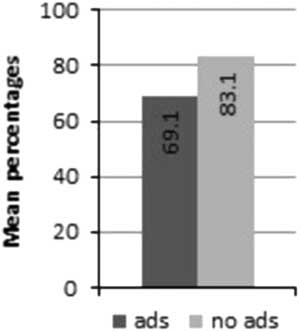
Figure 1 Main test results by advertisements
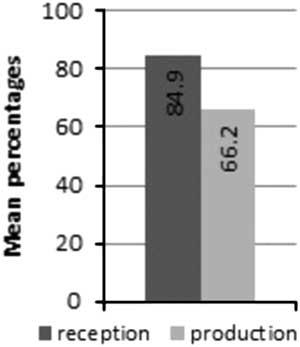
Figure 2 Main test results by task
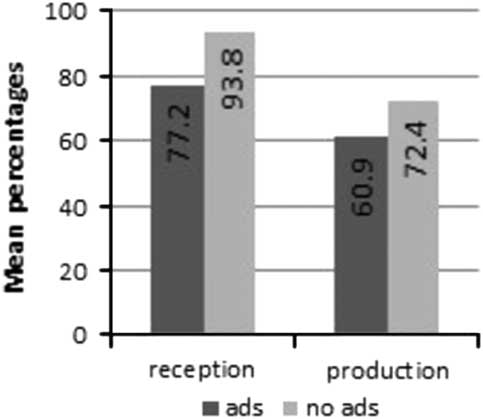
Figure 3 Interaction task x ads for the main test
4.2 Time
4.2.1 Overall time of test performance
On average, the participants needed 18 minutes and 34 seconds (SD=276.46) to do the test when the dictionary included advertisements, and 15 minutes and 29 seconds (SD=262.52) when the advertisement-free dictionary version was offered for consultation. The difference of 3 minutes and 5 seconds was statistically significant (p<0.001, t test for independent samples). It should also be noted that the presence of advertisements in OALD9 not only extended the time of task performance but also led to greater variance.
4.2.2 Time of task performance for a test item
On average, it took the participants 43 seconds to complete the tasks for a test item when they saw advertisements, and 36 seconds when there were no advertisements in the dictionary (see Figure 4). The results of the 2 x 2 repeated measures ANOVA reveal that the effect of advertisements on the mean time of test completion for a test item was statistically significant and large (F=17.44, p<0.001, partial η2=0.421). Importantly, over 42% of the between-groups variance in the time of task performance can be attributed to the presence of advertisements in the dictionary.
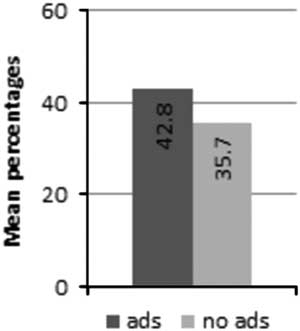
Figure 4 Time for a test item by advertisement
Quite predictably, production was more time-consuming than reception. Forming an original sentence with a test item took on average 49 seconds, but only 30 seconds were needed to explain the meaning of a new word (see Figure 5). The difference of 19 seconds was statistically significant (F=99.11, p<0.001, partial η2=0.805).
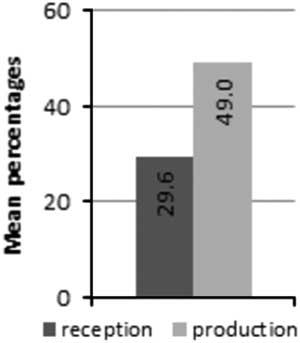
Figure 5 Time for a test item by task
The interaction effect between advertisement and task was statistically significant, too (F=6.53, p=0.02, partial η2=0.214). When the dictionary included advertisements, the participants spent on average 36 seconds explaining the meaning of a test item, and 50 seconds using the word in an original English sentence. When the advertisement-free dictionary version was consulted, the explanation of the meaning of a test item took on average 23 seconds, but the participants needed over twice as long (48 seconds) to formulate an original English sentence using the word (see Figure 6). In both experimental conditions (advertisements and no advertisements), the effect of task was statistically significant: reception was significantly faster than production (advertisements: reception 36 seconds vs. production 50 seconds, p<0.001; no advertisements: reception 23 seconds vs. production 48 seconds, p<0.001, Tukey HSD test). Yet, the effect of advertisement was different in each task. Advertisements significantly slowed down meaning explanation, which, on average, took 13 seconds (or about 60%) longer when the dictionary included advertisements (36 seconds [advertisements] vs. 23 seconds [no advertisements], 36*100/23=156.52, p<0.001, Tukey HSD test). However, advertisements prolonged sentence formulation only by 2 seconds (or 4%; 50 seconds [advertisements] vs. 48 seconds [no advertisements], 50*100/48=104.17), which was far from a statistically significant influence (p=0.81, Tukey HSD test).
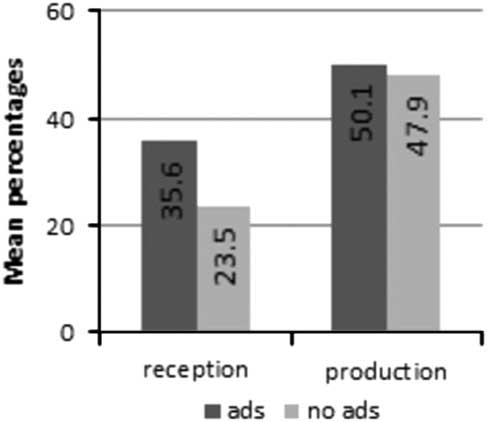
Figure 6 Time for a test item by task x advertisement
4.3 Retention
The participants remembered almost half as much again after the consultation of the advertisement-free OALD9 Premium (43.7%) as after reference to the regular online version of OALD9 (29.6%; 43.7*100/29.6=147.64; see Figure 7). The negative effect of advertisement on meaning retention was statistically significant and strong (F=12.13, p<0.001, partial η2=0.336; one-way ANOVA); over one third of the between-subjects variance can be attributed to the presence of advertisements in the dictionary.
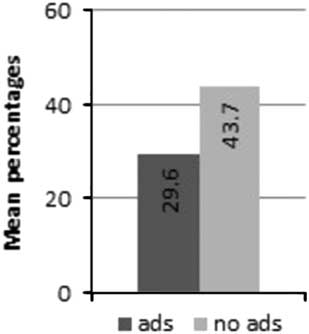
Figure 7 Retention results by advertisements
4.4 Summary of the results
The research reveals a strongly negative influence of advertisements in OALD9 on the comprehension of new words and their use (Research Question 1). Both decoding and encoding were impaired by around one fifth (reception 22%, production 19%) if dictionary users were exposed to advertisements.
Another important finding from the study is that the advertisements included in the OALD9 website significantly extended the overall time of test completion, mainly because they made receptive task completion about 60% more time-consuming, which was a statistically significant influence. Sentence formation on the basis of the free dictionary version with advertisements was only marginally longer than that based on the advertisement-free OALD9 Premium (Research Question 2).
Finally, the study reveals that, unfortunately, advertisements significantly inhibited dictionary-based retention of meaning (Research Question 3). Nearly half as much again was retained when the advertisement-free dictionary was consulted.
5 Discussion
In the current study, reception and production were significantly impaired by advertisements, and the effect was comparable in both tasks (22% and 19% respectively). Interestingly, other research shows that the distraction generated by animated advertisements decreases with the increasing complexity of the task. Pagendarm and Schaumburg (Reference Pagendarm and Schaumburg2001) found that Internet users who perform a goal-directed search employ cognitive schemata that suppress the processing of animated web advertisements, as opposed to those who browse a website aimlessly.Footnote 7 Also, Zhang (Reference Zhang2000) noted that simple tasks are much more affected by animated advertisements than more difficult ones.Footnote 8 More recently, Kuisma (Reference Kuisma2015: 45) observed that advertisements “were attended significantly more during free browsing than during the reading task performance.” As Hadlington (Reference Hadlington2017: 62) explains, “this could be directly linked to the limited resources individuals have at their disposal when conducting … complex tasks, with little or no spare capacity to deal with extraneous input that is not relevant to the task in hand.” However, in the current study, the difference in success rates in the receptive (easier) and productive (more difficult) tasks (cf. section 4.1, Figure 2) is only 3 percentage points in favor of the former, and is not statistically significant. There are many reasons why the results from this research are not consistent with previous findings suggesting that the effect of advertisements is conditioned by task orientation or task complexity. First, in the current investigation, not all advertisements were (always) animated (cf. section 2.2). Second, as noted in section 2.2, advertisements in the free OALD9 online are based on retargeting. They thus constitute individualized “recommendation systems” that “highlight the specific products that the consumer was browsing before leaving the website” (Lambrecht & Tucker, Reference Lambrecht and Tucker2013: 561). As such, they were bound to vary across the computers employed in the study, previously used by different students in the computer lab, and, by the same token, across the participants, which is an important limitation of the study. Quite interestingly, even colors used in animations, let alone their content, have been reported to affect performance: vivid colors in animations have been found to exert a stronger negative impact on performance than dull ones (Zhang, Reference Zhang2000). These, along with other elements of advertisement design and semantic appeal, change if advertisements are retargeted. All these factors that account for the variability in the advertisements in the free version of OALD9 online (accessed on different machines by different users) might have made it more difficult to isolate the role of task in moderating the effect of advertisement on task performance. This endeavor would have been much easier if the content and design of advertisements had been controlled. Further investigations could possibly impose much more control in this respect to determine whether differences in task load affect the role of advertisements in online dictionaries.
Another possible reason why the influence of advertisements on decoding and encoding was not conditioned by task difficulty was the nature of the current study. It can be expected that reception, even though less difficult than production, was much more demanding than aimless browsing of web pages in the study by Pagendarm and Schaumburg (Reference Pagendarm and Schaumburg2001). Meaning comprehension must also have been more challenging than counting letters in two-letter strings in the investigation by Zhang (Reference Zhang2000). In other words, it is very likely that the cognitive loads of the receptive and productive tasks in the current experiment were different from the loads of the tasks described as easy and difficult in the aforementioned investigations. In particular, it seems that meaning comprehension was too hard to leave free cognitive powers that could be devoted to the processing of advertisements.
It is interesting to note that the results from the experiment that refer to task completion time (reception extended by 60%, and production prolonged only slightly and not significantly) coincide with previous findings that point to a substantial influence of the nature of task on the distracting effect of online banner advertisements (cf. Diaper & Waelend, Reference Diaper and Waelend2000; Zhang, Reference Zhang2000). Burke, Hornof, Nilsen and Gorman (Reference Burke, Hornof, Nilsen and Gorman2005) observed that in the presence of advertisements, including colored graphics, search time was much longer when the participants were doing an easy task, which consisted in finding exact matches of given headlines, than a more difficult one, in which sentence searches necessitated semantic transformation. In other words, search time was more adversely affected in the simple task than in the harder one. Burke et al. (Reference Burke, Hornof, Nilsen and Gorman2005) suppose that simple tasks demand less attention, which means that task-irrelevant stimuli might be perceived and processed, which, in turn, prolongs task completion. A difficult task, on the other hand, requires more concentration, thereby reducing the processing available for irrelevant stimuli, which are thus more likely to be ignored. As noted previously, in the current study, reception was significantly easier than production. It is thus possible that advertisements significantly extended the time of receptive task completion, but not the time of productive task completion (Research Question 2, cf. section 4.2.2, Figure 6), because of the nature of the tasks. Less cognitive effort is invested in meaning comprehension than sentence framing. Presumably, the easier task left more cognitive powers free to attend to advertisements, which, in turn, increased distraction and prolonged the time of task completion. Production, the more difficult of the two, involved more focus, left little processing available for advertisements, and reduced the susceptibility to the distraction generated by them. This might even have resulted in banner blindness, or inattention to advertisements (Benway & Lane, Reference Benway and Lane1998; Burke et al., Reference Burke, Hornof, Nilsen and Gorman2005), and faster performance. Overall, the current study seems to support the conclusions drawn by Burke et al. (Reference Burke, Hornof, Nilsen and Gorman2005: 442–443) that “the nature of the primary task strongly interacts with the attention-getting capacity of the banners” and that “success in avoiding banners may be dependent on the cognitive complexity of … tasks.”
Unfortunately, the study also reveals that advertisements significantly impede dictionary-based meaning retention. In all likelihood, advertisements and dictionary content compete for users’ attention, and the presence of advertisements raises cognitive effort in dictionary users, who either look at and read them, or try to avoid them. Each of these two activities reduces the chances of remembering the dictionary content. In other words, if more mental attention is directed to (noting or ignoring) non-essential website material, it may be expected that less dictionary information will be retained. Interestingly, this regularity was not found for non-dictionary websites (McCoy et al., Reference McCoy, Everard, Galletta and Polak2004).
Overall, the present investigation shows that the widespread business model where advertisements support online dictionaries available to users free of charge, quite sadly, does not serve language reception, production, and learning. It also costs online dictionaries much of their usefulness in terms of consultation time. The latter is quite disquieting, considering the fact that the speed of electronic dictionary consultation is commonly seen to be one of the greatest advantages of electronic dictionaries over paper ones (De Schryver, Reference De Schryver2003; Dziemianko, Reference Dziemianko2012; Levy & Steel, Reference Levy and Steel2015; Müller-Spitzer, Koplenig & Töpel, Reference Müller-Spitzer, Koplenig and Töpel2011; Prinsloo, Reference Prinsloo2005; Stirling, Reference Stirling2003; Tang, Reference Tang1997; Tono, Reference Tono2000). Interestingly, it may be surmised that placing advertisements on dictionary websites does not necessarily have to be the most effective marketing strategy, either. Dictionary consultation is typically (if not always) goal-oriented, as hardly anybody browses dictionaries for pure pleasure. It has been found that banner advertisements are less successfully recalled and recognized by web users who browse a website in the goal-oriented mode than by those who just surf the website without a clear aim (Danaher & Mullarkey Reference Danaher and Mullarkey2003). As such observations do not come from research conducted for dictionary websites, it might be interesting to see whether they hold also for online dictionaries. It can be expected, however, that goal orientation in the process of consulting an online dictionary is “likely to result in more focused viewing of web content and less attention to peripheral material like advertising” (Danaher & Mullarkey, Reference Danaher and Mullarkey2003: 254).
6 Limitations of the study
Although the current study provides clear evidence for the negative impact of advertisements in OALD9 on language comprehension, production, retention, and the time of meaning comprehension on the basis of dictionary consultation, it is not free from limitations. First, each selected vocabulary item used in the study has only one sense in OALD9, except for kudos, which has a two-sense entry. The main lexicographic content is thus relatively short, and the whole entry can always be seen on the computer screen without scrolling. At the same time, this also means that the main content may appear exceptionally dwarfed by advertisements, which virtually surround, if not overwhelm, a short dictionary entry, as shown in Figure 8 and Appendix A.
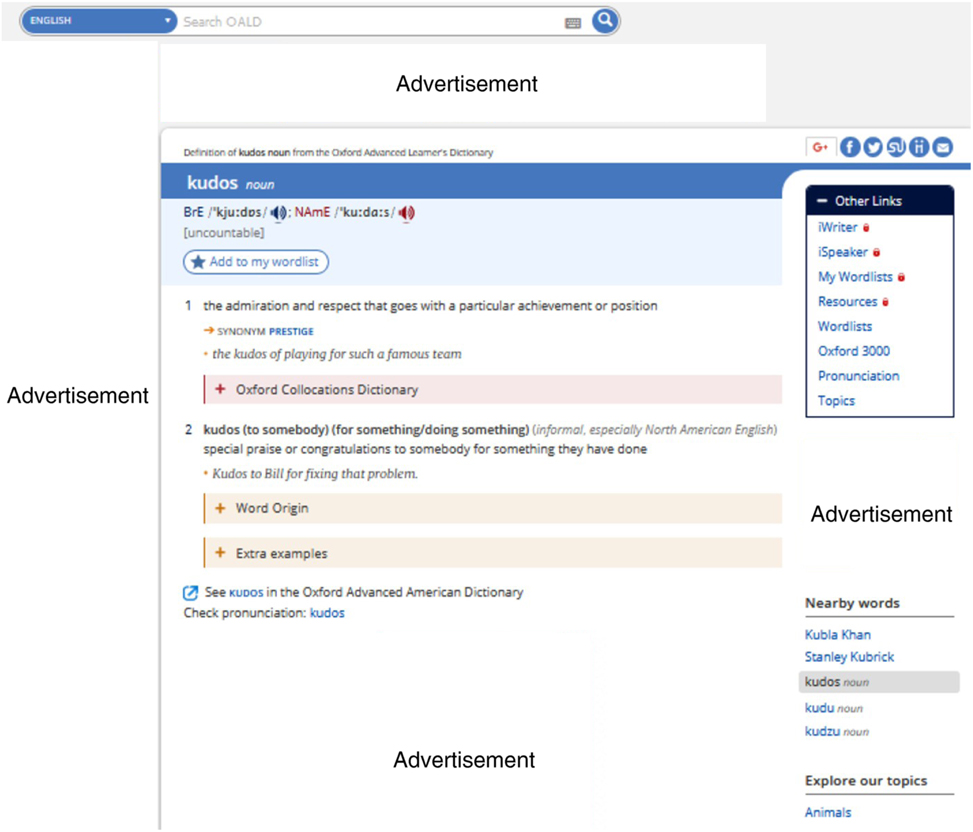
Figure 8 OALD9 entry for kudos (the free online version)
As can be seen, even in the case of kudos, which had the longest entry in the experiment, all the advertisements could be seen on the free OALD9 website. In the case of longer entries, only the biggest banner adverts above the search window and to the left of the entry are immediately visible when the entry is accessed; the other advertisements appear as the user scrolls down the entry to access further senses. In the future, research should reveal whether advertisements on dictionary websites also have a negative effect on language comprehension, use, and retention when more polysemous words are looked up.
Second, the sample of words used in the experiment was not balanced with respect to the part of speech. Among the 13 lexical items selected, there were two verbs and 11 nouns (see section 2.1). Although investigating the significance of the grammatical category of headwords for consultation time, reception, and production was not the aim of the study, it might be worth including the part of speech as a variable in further research.
As noted in section 3, the current research was conducted in a computer lab. This setting allows strict control over experimental conditions, and, in particular, ensures that the screen size and browser settings are the same for all the participants. Unfortunately, it makes the setting far from natural. It would be extremely interesting to observe dictionary users’ natural behavior and reactions to advertisements when they consult online dictionaries in their most typical setting, such as at home, at work, or on language courses. This also implies that other dictionary user groups should be targeted, not only university students. Language teachers, translators, or scientists writing publications are just a few examples of online dictionary user groups that further investigations could involve.
It may be expected that in a natural setting, the distracting effect of advertisements could be even more profound. As pointed out above, in the current investigation, the students were seated at computers that had previously been used by other students. Thus, the advertisements that they saw in the dictionary were not based on their browsing history; the experiment was conducted at the beginning of the class, before the participants had had a chance to surf the Internet. Thus the advertisements were not targeted specifically at them, but reflected the browsing interests of previous computer users in the same computer lab. In a natural setting, dictionary users are distracted by the advertisements of the products and services that they are likely to be genuinely interested in based on their individual browsing history (and which they look for on the Internet), which might simply add to the distracting power of advertisements.
The distraction generated by advertisements might also depend on the vocabulary items that are looked up. In the present investigation, a small number of target words were used, which had been arbitrarily selected by the researcher from a bigger set recently added to OALD9 online (see section 2.1), and perhaps were not the most typical target words. Put differently, they may not have aroused the participants’ genuine interest inasmuch as they were not needed in a real situation of information deficit experienced in a natural setting. To gain more insight into the role of advertisements in online dictionary consultation, in further experiments participants should look up words that they really need in a given situational context. It may be hypothesized that advertisements would then be less distracting, as dictionary users might be more interested in the words they are looking up. On the other hand, such a design would introduce a large amount of item variability, which could be attributed to the different items triggering dictionary consultation. Unfortunately, it would not control advertisement variability across dictionary users, either.
In fact, the variability of advertisements is unknown in the current study, and it is bound to remain unknown in further experiments conducted in more natural settings and circumstances, where advertisements based on previous browsing history would be targeted precisely at specific users. It needs to be remembered that dictionaries should “provide information which can be used to solve specific types of need related to communication, language learning and knowledge acquisition” (Gouws & Tarp, Reference Gouws and Tarp2017: 396). Unfortunately, dictionaries, including those on the web, provide users with superfluous data in a given consultation act, a phenomenon known as data overload. Advertisements contribute to non-lexicographic data overload, as they are not even “remotely related to the lexicographic endeavour,” and are “irrelevant and disturbing” (Gouws & Tarp, Reference Gouws and Tarp2017: 399). Indeed, the current study confirms what many ordinary dictionary users suspect: advertisements in online dictionaries impede the success of dictionary consultation and prolong the look-up process. In fact, advertisements are one of the most important manifestations of data overload in dictionaries available on the Internet, which is a real challenge to be reckoned with. After all, data overload may not only obstruct dictionary consultation or extend it in time; it may also make users retrieve wrong information, quit dictionary consultation, grow more skeptical towards dictionaries, or even turn to other sources of information (Gouws & Tarp, Reference Gouws and Tarp2017). In fact, this already happens – people often rely on Internet search engines to support simple linguistic tasks, which naturally means that dictionary websites are likely to be losing traffic (Fourney, Morris & Whyte, Reference Fourney, Morris and Whyte2017; Zimmer, Reference Zimmer2017). This may only aggravate the precarious situation for free online dictionaries, to which profuse advertising on dictionary websites not doubt contributes.
7 Recommendations for further research
In order to precisely determine the effect of advertisements on dictionary use, it might be useful to control advertisement variability in further studies. To reduce the risk of advertisements varying across dictionary users (and even across consecutive lookups performed by one user), they should be the same for all the participants. This could be achieved, for example, by modifying and controlling (or even fabricating) dictionary websites, at least for the words used in experiments, so that advertisements included there would remain the same whenever a given word is looked up.
It might also be interesting to investigate whether the number of advertisements and their distribution on a website make a difference to dictionary usefulness. In the free online version of OALD9 used in the experiment, advertisements were placed in four positions: above the headword, to the left of the entry, at the bottom of the entry, and on the right below Other links and Other results (see section 2.2 and Appendix A). These localizations are by no means the only possible ones in an online dictionary (cf. Gouws & Tarp, Reference Gouws and Tarp2017; Zimmer, Reference Zimmer2017). It might be worthwhile to conduct further research in which the number and positioning of advertisements on a dictionary website are manipulated to see if these factors affect language reception, production and meaning retention, as well as the time of information retrieval. It may be hypothesized that a smaller number of advertisements would be less distracting to dictionary users. Further research might also make it possible to identify optimal (the least distracting) advertisement distribution on dictionary websites. It appears that in this respect, reliance on eye-tracking methodology could prove invaluable. Naturally, it needs to be remembered that empirical research into optimizing the amount and positioning of advertising on dictionary websites will have to be juxtaposed with business expectations, and reconciling user-oriented research findings with publishers’ profit-oriented goals might prove difficult.
Currently, the free OALD9 website features both static and animated advertisements (cf. section 2.2). It might be worth examining whether animated ones are as detrimental as static ones to language reception, production, and learning on the basis of dictionary consultation. The conclusion is by no means obvious, because animation was shown not to make task-irrelevant advertisements any more conspicuous – people do not tend to look at animated banners more often than at static ones (Burke et al., Reference Burke, Hornof, Nilsen and Gorman2005). It is even claimed that “animation may not provide a benefit to advertisers: In fact, it may even cost an ad’s success” (Burke et al., Reference Burke, Hornof, Nilsen and Gorman2005: 442). On the other hand, animation in advertisements has been observed to grab viewers’ attention (even against their will) and result in negative attitudes (Zhang, Reference Zhang1999, Reference Zhang2000, Reference Zhang2006). It has also been found that animation on the left side of the screen is the most disturbing (Zhang, Reference Zhang2001). Further experiments into the role of advertisements on dictionary websites should also deal with yet another aspect of advertisement variability. It is not known whether advertisements incongruent with the dictionary content are more or less disturbing than those that are remotely related to the lexicographic endeavor (and promote, e.g., other lexicographic products or language learning software; cf. section 2.2). Thus, it might be useful to combine several factors, such as type, number, and distribution of advertisements on dictionary websites in further research so as to be able to optimize online dictionary design, bearing in mind the needs both of dictionary users and publishers. Assuming that removing advertisements from a free online dictionary website is just wishful thinking, detailed empirical research can indicate ways of controlling the advertisements included there so that online dictionary publishers gain their benefits, but with possibly little negative effect on the dictionary consultation process.
It might also be interesting to see whether the negative impact of advertisement in free online dictionaries accessed on stationary PCs, demonstrated in the current investigation, applies to mobile devices on which free online dictionaries can be assessed, such as tablets or smart phones. Admittedly, Müller-Spitzer, Koplenig and Töpel (Reference Müller-Spitzer, Koplenig and Töpel2012: 433) found that online dictionaries are consulted most often on desktop computers (56.50%) and notebooks/netbooks (42.45%), while mobile phones, smartphones, or personal digital assistants serve much less often as the primary devices to access online dictionaries (1.05%). More recently, Kosem, Lew, Müller-Spitzer and Wolfer (Reference Kosem, Lew, Müller-Spitzer and Wolfer2017) have shown that although smartphones are the devices most often used these days (82.7%), the usual monolingual dictionary format is still, quite surprisingly, computer-based (79.4%), followed by print (57.1%). Monolingual dictionaries are much less often accessed on smartphones (36.6%) or tablets (13.7%). A possible explanation might be that monolingual dictionaries are not available for mobile devices, or, considering the fact that the preferred format is still computer-based, dictionaries might be used extensively while people are seated in front of the computer for work or study. Nevertheless, it can be expected that with the increasing availability of the mobile web and falling prices of portable devices, mobile dictionary access will increase in the coming years.
It should also be noted that in other parts of the world, mobile dictionary access cannot be equated with Internet-based dictionary access. In the Far East and the Indian subcontinent, stand-alone pocket electronic dictionaries are highly popular (Boonmoh, Reference Boonmoh2010; Deng, Reference Deng2005; Midlane, Reference Midlane2005; Nesi, Reference Nesi2009, Reference Nesi2012, Reference Nesi2015). Yet even there they are being supplanted by Internet-enabled devices (Nesi, Reference Nesi2015: 586). After all, stand-alone pocket electronic dictionaries “are designed for private use; they are relatively expensive and are generally purchased by individuals rather than … educational institutions” (Nesi, Reference Nesi2009: 466). Although such dictionaries may be useful to those who do not have an Internet connection, they are being superseded by smartphones, which, among others, enable access to online dictionaries as well as (free) download of dictionary apps. Quite surprisingly, stand-alone pocket electronic dictionaries may be gaining ground in (some parts of) Europe. For example, in Wuppertal they have been introduced to secondary and comprehensive schools to see if they contribute to developing learner autonomy and language skills (Diehr, n.d.).
8 Conclusions
Overall, the current study exhibits a statistically significant and negative influence of advertisements in OALD9 website on reception, production, the time of new word comprehension, and meaning retention. The investigation definitely justifies recommending the advertisement-free, Premium version of OALD9 for language learners. Although it would be overoptimistic to expect commercial publishers to eschew the widespread business model where (high-quality) dictionary content can be provided for free thanks to advertisements, it might be worth considering the provision of premium, advertisement-free dictionary versions for a small charge. In fact, online dictionary publishers might be reluctant to set more modest business goals and allow fewer advertisements on popular dictionary websites. That is why it might be worthwhile to reconsider (and research) the optimization of advertisement types on such websites.
Ethical statement
The data gathered for the purpose of the experiment were completely anonymized. All the participants were adult university students and gave prior informed consent to participate. Participation was voluntary, and there was the possibility to withdraw at any time. The experiment constituted an extension of tasks done in class, so inflicting any psychological damage on the participants is highly unlikely. The participants were treated in accordance with the provisions of Polish law.
Author ORCiD
Anna Dziemianko, https://orcid.org/0000-0002-6325-2948
Appendix A.
OALD9 entry for bae (free online version)
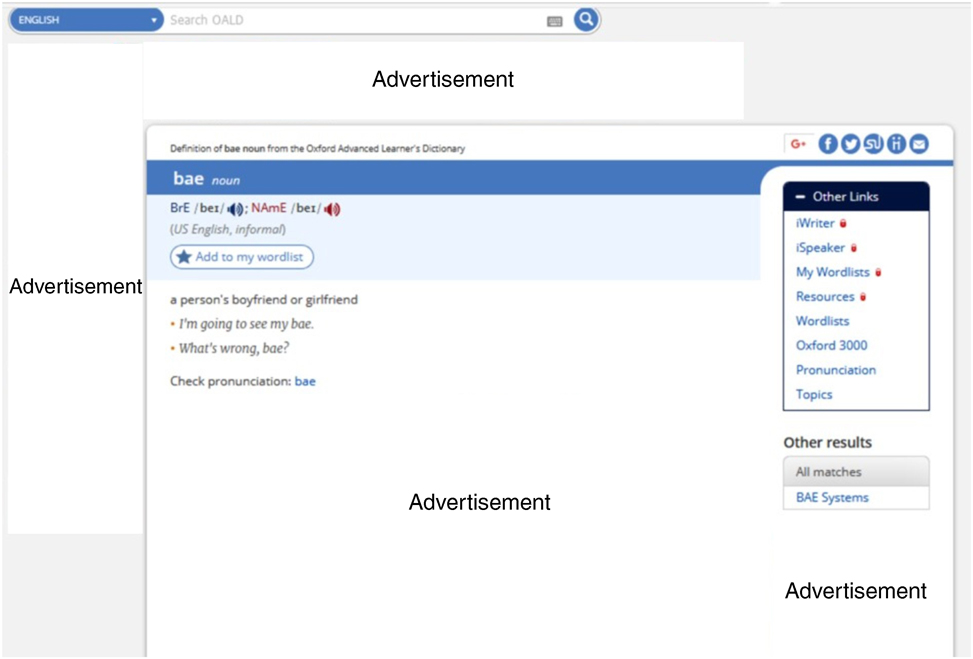
Appendix B.
OALD9 entry for bae (Premium version)
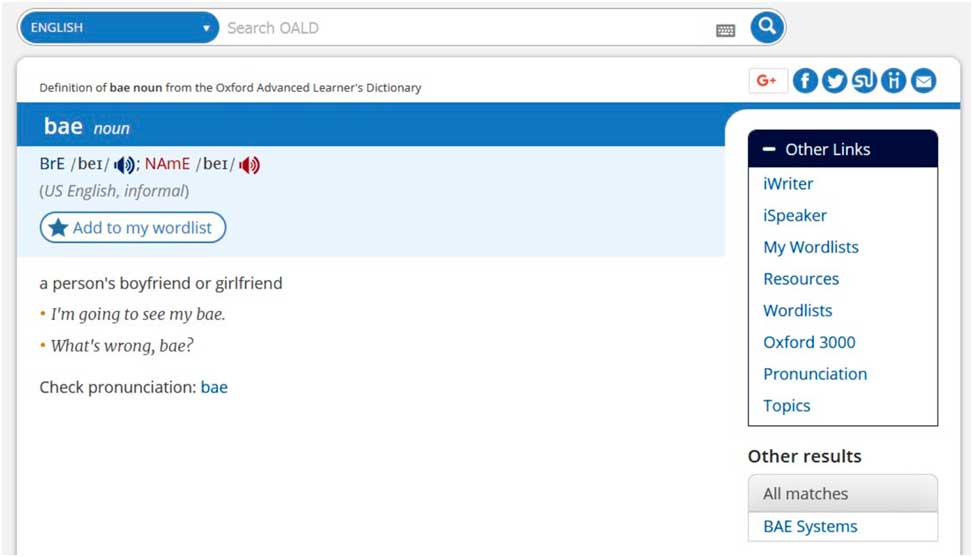
About the author
Anna Dziemianko is a university professor at Adam Mickiewicz University in Poznań, Poland. Her research interests include English pedagogical lexicography, user studies, syntax in dictionaries, defining strategies, and the presentation and distribution of lexicographic data on dictionary websites. She has researched the relative usefulness of paper and electronic dictionaries.


